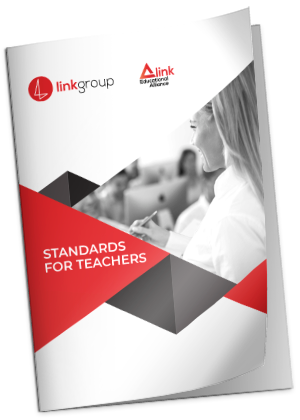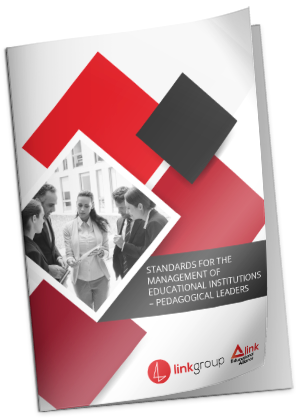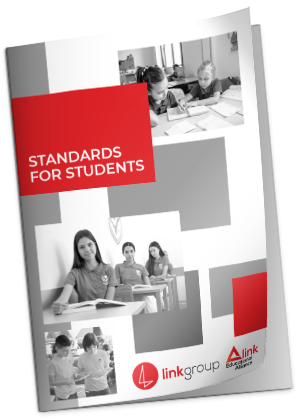The LINK Edu Alliance adopts documents prescribing the highest standards at its institutions
For a number of years, educational institutions within the LINK Edu Alliance have been known for the high quality of teaching and service that meets the highest global standards and principles of excellence. It is this nonpareil quality that makes every school, institution or service of the LINK Edu Alliance immediately recognizable to students.
The Alliance, which comprises primary and secondary schools, colleges, faculties, prestigious academies for professional development, institutes for contemporary education and numerous educational services, has now taken an extremely important step in raising the quality of education:
The LINK Edu Alliance has adopted official standards, procedures and handbooks designed to ensure that teaching of the highest quality and standards is implemented in all institutions of the Alliance.
The adopted LINK standards are the result of a comprehensive and expert analysis of the best modern teaching methods, experience in the use of technology in teaching, the desire to have the most effective teaching process, and the need to harmonize activities with defined and legally established standards and regulations.
Finally, LINK standards are based on decades of successful work of educational institutions within the LINK Educational Alliance, proven practices applied in the best schools in the world, and the implementation of high EU standards regarding the quality of teaching and education.

Owing to these high standards, whose implementation will be regularly monitored and enhanced, students from all over the world can be sure that, no matter which LINK institution they attend or whichever service they use, they will get the highest level of quality LINKgroup is known for.
10 principles of LINK standards
- Quality education is a universal human right and, as such, is a prerequisite for the successful functioning of individuals and society.
- Quality education requires educational institutions to show excellence in all circumstances.
- Educated, qualified and competent staff is in charge of making sure the educational institution meets the highest standards in education, in accordance with the defined and legally established standards and regulations.
- The standards and practices of the educational institution must correspond to the needs of the educational institution, legal requirements, contemporary needs and requirements of individuals and society.
- The quality of an educational institution is a prerequisite for endorsing values, making the right decisions and choices, as well as a prerequisite for success in people’s private, social and professional lives.
- The quality of an educational institution entails an effective, ethical, socially responsible and ecological practice.
- All members of the educational institution community have a common goal to provide quality education to all students, and to cooperate and nurture communication based on respect and understanding.
- Educational institutions use the Handbook for the Self-Evaluation of Educational Institutions for the purpose of self-assessment, modification of practices and activities, and support for all members of the educational institution’s community.
- The quality of an educational institution is reflected in ethical, environmental and professional activities, while respecting general principles and rules of conduct, and the implementation of activities that contribute to the common good of all members of society.
- All members of the educational institution's community constantly evaluate, modify and improve their practices and activities, enhancing the quality of the work so as to support the students, teachers, parents and the community, regardless of the circumstances.
Documents which guarantee the implementation of LINK standards
1) Handbook for the Self-Evaluation of LINK Standards in Educational Institutions
 The self-evaluation process is extremely important when it comes to implementing LINK standards in the company’s educational institutions. It refers to quality assurance, but also to the methods for enhancing current practices and approaches. The goal of self-evaluation is to provide the highest standards and the implementation thereof on a daily basis.
The self-evaluation process is extremely important when it comes to implementing LINK standards in the company’s educational institutions. It refers to quality assurance, but also to the methods for enhancing current practices and approaches. The goal of self-evaluation is to provide the highest standards and the implementation thereof on a daily basis.In other words: the self-evaluation of LINK standards aims to assess the quality of an educational institution by identifying positive examples and practices whose implementation should be a priority, as well as the elements that need improving. Consequently, each educational institution can plan measures and procedures for enhancing standards so as to provide its students with top-quality teaching.
The evaluation is carried out by a team of renowned experts whose task is to check the key indicators of good teaching based on different sets of data within a set time frame. This process entails a detailed analysis of the following areas:
- mission and vision of the educational institution;
- organizational quality of the educational institution and its management;
- teaching quality;
- quality support systems for the students, teachers, associates and parents;
- development of the activities carried out by the educational institution.
2) LINK Standards for Teachers
 Teachers in the LINK Edu Alliance educational institutions are required to meet high standards, which imply a synergy of professional competencies, high ethical principles and the necessary activities for creating the best teaching practices.
Teachers in the LINK Edu Alliance educational institutions are required to meet high standards, which imply a synergy of professional competencies, high ethical principles and the necessary activities for creating the best teaching practices.LINK standards for teachers are guidelines according to which teachers should design their lessons and promote professional integrity. They include:
- enhancement of competencies and innovation in teaching;
- responsibility for increasing the students’ level of knowledge and competence;
- fostering professionalism and work ethic.
3) LINK Standards for Educational Leaders
 Educational leaders are an important part of the LINK Edu Alliance. They are in charge of improving teaching processes and raising the quality of educational institutions.
Educational leaders are an important part of the LINK Edu Alliance. They are in charge of improving teaching processes and raising the quality of educational institutions.The standards are guidelines which educational leaders use to improve their own approach, and to have a fair and objective approach to the evaluation of educational institutions.
The standards are designed to encourage educational leaders to be dedicated to:
- developing their own competencies, values, principles and effective management skills;
- fulfilling their role in enhancing the education institution;
- advancing their professionalism and work ethic.
4) LINK Standards for Students
 The standards for students are a fruitful combination of values, principles, academic competencies and activities for promoting lifelong learning, the development of socio-emotional, digital and academic competencies, as well as a responsible attitude towards the students’ work, progress and future.
The standards for students are a fruitful combination of values, principles, academic competencies and activities for promoting lifelong learning, the development of socio-emotional, digital and academic competencies, as well as a responsible attitude towards the students’ work, progress and future.The standards contain guidelines and instructions for implementing activities that will produce educational outcomes enabling LINK students to undergo professional development, develop critical thinking and problem solving skills, contribute to the world around them in a creative fashion, and respond to the professional requirements of the 21st century.
The standards particularly focus on the three key areas for the students’ holistic development:
- academic development;
- socio-emotional development;
- psychophysical development.
LINKgroup – a synonym for quality
LINK Edu Alliance institutions have long been synonymous with quality when it comes to education on all levels. The Alliance’s standards, principles and practices have made LINK institutions the leading educational institutions when it comes to international education. Now is the perfect moment to enhance the implementation of said standards by incorporating them into official documents.



Leave a comment